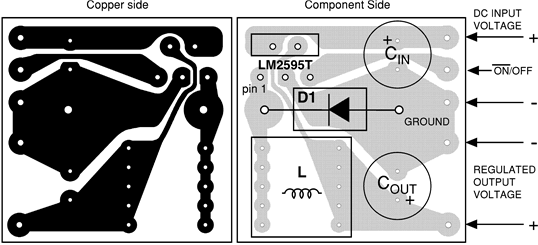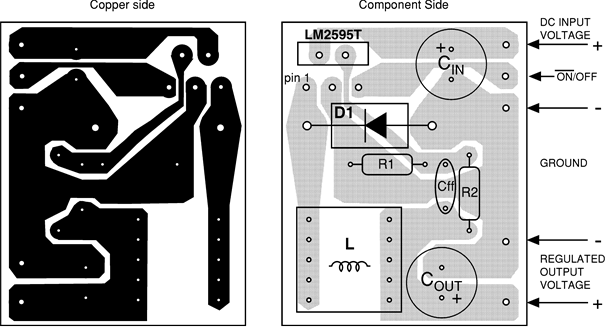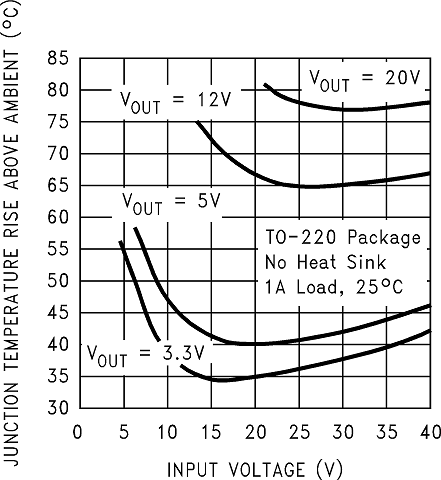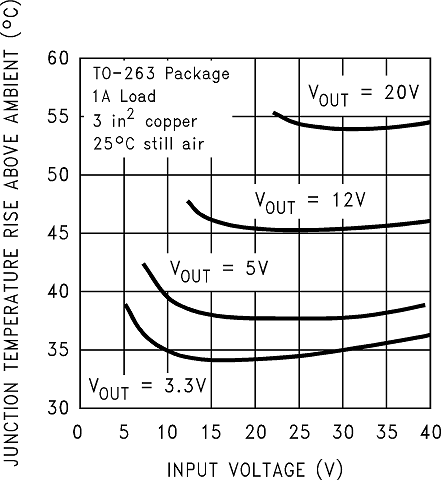SNVS122C May 1999 – May 2016 LM2595
PRODUCTION DATA.
- 1 Features
- 2 Applications
- 3 Description
- 4 Revision History
- 5 Description (continued)
- 6 Pin Configuration and Functions
-
7 Specifications
- 7.1 Absolute Maximum Ratings
- 7.2 ESD Ratings
- 7.3 Recommended Operating Conditions
- 7.4 Thermal Information
- 7.5 Electrical Characteristics - 3.3 V
- 7.6 Electrical Characteristics - 5 V
- 7.7 Electrical Characteristics - 12 V
- 7.8 Electrical Characteristics - Adjustable
- 7.9 Electrical Characteristics - All Output Voltage Versions
- 7.10 Typical Characteristics
- 8 Detailed Description
- 9 Application and Implementation
- 10Power Supply Recommendations
- 11Layout
- 12Device and Documentation Support
- 13Mechanical, Packaging, and Orderable Information
封装选项
请参考 PDF 数据表获取器件具体的封装图。
机械数据 (封装 | 引脚)
- NDH|5
- KTT|5
散热焊盘机械数据 (封装 | 引脚)
- KTT|5
订购信息
11 Layout
11.1 Layout Guidelines
As in any switching regulator, layout is very important. Rapidly switching currents associated with wiring inductance can generate voltage transients which can cause problems. For minimal inductance and ground loops, the wires indicated by heavy lines must be wide printed circuit traces and must be kept as short as possible. For best results, external components must be placed as close to the switcher lC as possible using ground plane construction or single point grounding.
If open core inductors are used, take special care regarding the location and positioning of this type of inductor. Allowing the inductor flux to intersect sensitive feedback, lC groundpath and COUT wiring can cause problems.
When using the adjustable version, take special care regarding the location of the feedback resistors and the associated wiring. Physically place both resistors near the IC, and route the wiring away from the inductor, especially an open core type of inductor (see Open Core Inductors for more information).
11.2 Layout Examples

COUT – 120-μF, 25-V aluminium electrolytic Nichicon, PL series
D1 – 3-A, 40-V Schottky rectifier, 1N5822
L1 – 68-μH, L30, Schottky, through-hole

COUT – 120-μF, 25-V aluminium electrolytic Nichicon, PL series
D1 – 3-A, 40-V Schottky rectifier, 1N5822
L1 – 68-μH, L30, Schottky through-hole
R1 – 1-kΩ, 1%
R2 – Use formula in Detailed Design Procedure
CFF – See Table 7
11.3 Thermal Considerations
The LM2595 is available in two packages: a 5-pin TO-220 (NDH) and a 5-pin surface-mount TO-263 (KTT).
The TO-220 package can be used without a heat sink for ambient temperatures up to approximately 50°C (depending on the output voltage and load current). Figure 40 shows the LM2595T junction temperature rises above ambient temperature for different input and output voltages. The data tor these curves was taken with the LM2595T (TO-220 package) operating as a switching regulator in an ambient temperature of 25°C (still air). These temperature rise numbers are all approximate and there are many factors that can affect these temperatures. Higher ambient temperatures require some heat sinking, either to the PCB or a small external heat sink.
The TO-263 surface-mount package tab is designed to be soldered to the copper on a printed-circuit board (PCB). The copper and the board are the heat sink for this package and the other heat producing components, such as the catch diode and inductor. The PCB copper area that the package is soldered to must be at least 0.4 in2, and ideally must have 2 or more square inches of 2 oz (0.0028 in) copper. Additional copper area improves the thermal characteristics, but with copper areas greater than approximately 3 in2, only small improvements in heat dissipation are realized. If further thermal improvements are required, TI recommends using double sided or multilayer PCB with large copper areas.
Figure 41 show the LM2595S (TO-263 package) junction temperature rise above ambient temperature with a 1-A load for various input and output voltages. This data was taken with the circuit operating as a buck switching regulator with all components mounted on a PCB to simulate the junction temperature under actual operating conditions. This curve can be used for a quick check for the approximate junction temperature for various conditions, but be aware that there are many factors that can affect the junction temperature.
For the best thermal performance, wide copper traces and generous amounts of PCB copper must be used in the board layout. (One exception to this is the output (switch) pin, which must not have large areas of copper.) Large areas of copper provide the best transfer of heat (lower thermal resistance) to the surrounding air, and moving air lowers the thermal resistance even further.
Package thermal resistance and junction temperature rise numbers are all approximate, and there are many factors that will affect these numbers. Some of these factors include board size, shape, thickness, position, location, and even board temperature. Other factors are, trace width, total printed-circuit copper area, copper thickness, single- or double-sided multilayer board, and the amount of solder on the board. The effectiveness of the PCB to dissipate heat also depends on the size, quantity, and spacing of other components on the board, as well as whether the surrounding air is still or moving. Furthermore, some of these components such as the catch diode will add heat to the PCB and the heat can vary as the input voltage changes. For the inductor, depending on the physical size, type of core material, and the DC resistance, it could either act as a heat sink taking heat away from the board, or it could add heat to the board.

| CIRCUIT DATA FOR TEMPERATURE RISE CURVE
TO-220 PACKAGE (NDH) |
|
| Capacitors | Through-hole electrolytic |
| Inductor | Through-hole, 68-μH Schottky |
| Diode | Through-hole, 3-A, 40-V Schottky |
| PCB | 3 square inches, single-sided 2-oz copper (0.0028″) |

| CIRCUIT DATA FOR TEMPERATURE RISE CURVE
TO-263 PACKAGE (KTT) |
|
| Capacitors | Surface-mount tantalum, molded D size |
| Inductor | Surface-mount, 68-μH, Schottky |
| Diode | Surface-mount, 3-A, 40-V, Schottky |
| PCB | 3 square inches, single-sided 2-oz copper (0.0028″) |